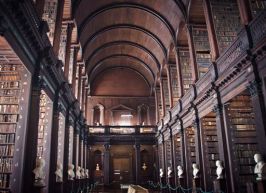
Great Expectations
- Coming-of-age story
- Victorian literature
What It’s About
What Makes a Gentleman?
Great Expectations is a coming-of-age tale with strong moral lessons about wealth and nobility, guilt and criminality, and conscience and self-deception. Throughout, various shadowy intrigues, a classic madwoman-in-the-attic, sinister plots and even a chase on the River Thames enliven the story. Its author, Charles Dickens, characteristically paces his narrative with plentiful mysteries and twists, including the true identity of Pip’s generous benefactor – the creator of Pip’s “great expectations.” The novel is simultaneously a bleak love story that pits the hero’s warmth and devotion against his love interest’s cynicism and cruelty. Pip’s very love for Estella drives his doomed pursuit of gentility and wealth. Despite its social satire, Great Expectations is, like most of Dickens’s oeuvre, ultimately a story of redemption – a feel-good tale apt to bolster your faith in humanity.
Summary
About the Author
Charles Dickens was born on February 7, 1812, in Portsmouth, England, where his father clerked in the Navy Pay Office. When Dickens was 12, his father spent three months in debtors’ prison – a hardship that Great Expectations’ Pip escapes only through Joe’s humble generosity. With a father in prison, young Charles toiled in a shoe-polish factory. His experience of the inhumane conditions of the working-class life would inform many of his works. After little formal education, Dickens became a solicitor’s clerk at age 15. At age 21, he published his first story, “A Dinner at Poplar Walk” – later republished as “Mr. Minns and His Cousin” – in a magazine. He married Catherine Hogarth, daughter of a newspaper editor, in 1836 and published his first novel, The Pickwick Papers, in 1837. The book earned him a following as a talented satirist and writer. As he would do with many of his major works, Dickens serialized the publication – that is, he published installments in a monthly journal, thus making the novel more affordable and accessible to all. The next year, in 1838, after the first of his 10 children was born, Dickens began publishing Oliver Twist. The laboring class and high society equally loved this book, launching Dickens to literary fame. Just a year later, in 1839, Dickens published Nicholas Nickleby. From 1843 to 1853, he published prolifically, including the novella A Christmas Carol and the novels David Copperfield and Bleak House. During the end of that decade, when Dickens was 39, he acted in a play with young writer Wilkie Collins, who would become his protégé. The two men formed a lasting – and quite famous – friendship. Great Expectations was Dickens’s 13th and last finished novel, following one year after his A Tale of Two Cities. Dickens began publishing The Mystery of Edwin Drood in 1870, but on June 9, 1870, at age 58, he died of a stroke. He is buried in the Poet’s Corner of Westminster Abbey.












Comment on this summary or Diskussion beginnen